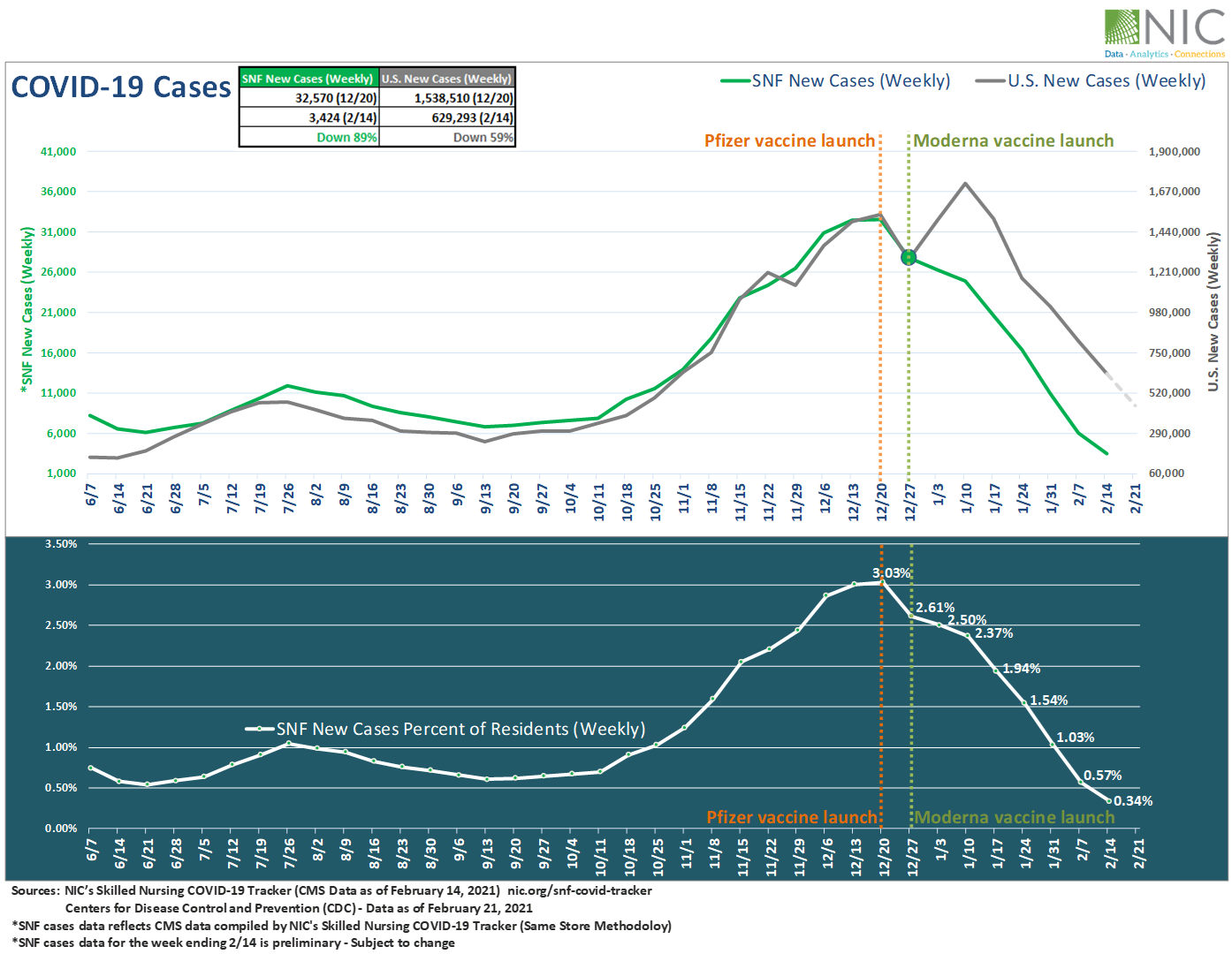NIC’s Skilled Nursing COVID-19 Tracker, featuring the most up-to-date CMS data as of February 14, 2021, shows that the per-resident rate of new COVID-19 infections in skilled nursing facilities continued to fall and reached a pandemic record-low point on February 14 (0.34%). This was 0.20 percentage points below the previous nadir of 0.54% reached eight months ago on June 21, 2020 and was down 2.69 percentage points from 3.03% at its peak on December 20.
Regionally, the lowest rate of new infections was seen in the Midwest at 0.22% – a pandemic low, followed by the West (0.23% – a pandemic low), the South (0.41% – a pandemic low), and then the Northeast (0.43%).
As of February 14, 2021, about 16 million Americans have received 2 doses of the COVID-19 vaccines in the U.S, and about 1.7 million people have been fully vaccinated in the Federal Pharmacy Partnership Program for Long-term Care.
Recent F.D.A. authorization of the Johnson & Johnson single-shot vaccine gives more hope and suggests that the worst of the pandemic maybe behind us. The characteristics of this new single-shot vaccine are a game changer and should increase vaccination numbers significantly.
Exhibit 1 below shows that weekly confirmed cases within skilled nursing facilities are down 89% from the December 20 peak, while U.S. new cases declined by 59% over the same period.
Exhibit 1 – Weekly COVID-19 Cases in Skilled nursing (SNF) vs. U.S.

As shown in Exhibit 2 below, weekly fatalities are down 75% in skilled nursing facilities since the launch of the Long-Term Care vaccination program on December 20. Sadly, U.S. weekly COVID-19 fatalities increased by 17% over the same period, according to the CDC. However, U.S weekly fatalities on February 21 fell more sharply than at any previous point—down 38% from the week ending February 14, 2021.
New fatalities in skilled nursing facilities as a share of total fatalities in the U.S. measured approximately 10% on February 7 and 7% on February 14 (data for the week ending February 14 is preliminary). These shares are the lowest recorded since CMS began reporting data in late May 2020.
Exhibit 2 – Weekly COVID-19 Fatalities in Skilled Nursing (SNF) vs. U.S.

“The week-over-week improvement in infections and death rates since late December is certainly welcome relief to the pandemic battle, we have been fighting for nearly one year,” said NIC Chief Economist, Beth Mace. “And the introduction of a third vaccine provides even further promise and hope that we may be nearing the end of the worst parts of this crisis. That said, the seniors housing and nursing care sectors have forever shifted and many of the protocols put into place during the past 12 months are likely to remain in place.”
Positive signals are palpable in Wave 22 results from the latest NIC Executive Survey Insights, which collected survey results from February 8 – 21, 2021. The survey results show that 50% of organizations with nursing care beds reported increasing occupancy rates in the past 30 days.
To gain in-depth insights and track the week-over-week change rate for new resident cases and fatalities of COVID-19 within skilled nursing facilities at the state and county levels, visit NIC.org. You can also access the Skilled Nursing COVID-19 Tracker along with a rich trove of analysis and insight on the NIC COVID-19 Resource Center.
For more reading on the effects of vaccines in skilled nursing facilities, see the following blogs:
New COVID-19 Cases in Skilled Nursing Continue Decline, Far Steeper than U.S. Overall Cases (Published on February 23, 2021)
Rate of New COVID-19 Infections in Skilled Nursing Facilities Continues to Plummet* (Published on February 17, 2021)
COVID-19 Case Counts Falling in Skilled Nursing Properties Following Vaccine Rollout (Published on February 9, 2021)
NIC is committed to provide timely data, analyses and insights that increase transparency and understanding of the sector, especially in this difficult time of COVID-19. We strongly support all actions and efforts that prioritize distribution of COVID-19 vaccines, testing, and availability of PPE to protect frontline workers and residents.